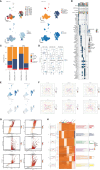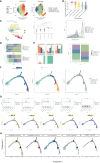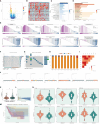Decoding the tumor microenvironment and molecular mechanism: unraveling cervical cancer subpopulations and prognostic signatures through scRNA-Seq and bulk RNA-seq analyses
- PMID: 38482016
- PMCID: PMC10933018
- DOI: 10.3389/fimmu.2024.1351287
Decoding the tumor microenvironment and molecular mechanism: unraveling cervical cancer subpopulations and prognostic signatures through scRNA-Seq and bulk RNA-seq analyses
Abstract
Background: Cervical carcinoma (CC) represents a prevalent gynecological neoplasm, with a discernible rise in prevalence among younger cohorts observed in recent years. Nonetheless, the intrinsic cellular heterogeneity of CC remains inadequately investigated.
Methods: We utilized single-cell RNA sequencing (scRNA-seq) transcriptomic analysis to scrutinize the tumor epithelial cells derived from four specimens of cervical carcinoma (CC) patients. This method enabled the identification of pivotal subpopulations of tumor epithelial cells and elucidation of their contributions to CC progression. Subsequently, we assessed the influence of associated molecules in bulk RNA sequencing (Bulk RNA-seq) cohorts and performed cellular experiments for validation purposes.
Results: Through our analysis, we have discerned C3 PLP2+ Tumor Epithelial Progenitor Cells as a noteworthy subpopulation in cervical carcinoma (CC), exerting a pivotal influence on the differentiation and progression of CC. We have established an independent prognostic indicator-the PLP2+ Tumor EPCs score. By stratifying patients into high and low score groups based on the median score, we have observed that the high-score group exhibits diminished survival rates compared to the low-score group. The correlations observed between these groups and immune infiltration, enriched pathways, single-nucleotide polymorphisms (SNPs), drug sensitivity, among other factors, further underscore their impact on CC prognosis. Cellular experiments have validated the significant impact of ATF6 on the proliferation and migration of CC cell lines.
Conclusion: This study enriches our comprehension of the determinants shaping the progression of CC, elevates cognizance of the tumor microenvironment in CC, and offers valuable insights for prospective CC therapies. These discoveries contribute to the refinement of CC diagnostics and the formulation of optimal therapeutic approaches.
Keywords: PLP2+ Tumor EPCs; ScRNA-seq; bulk RNA-seq; cervical cancer; experiment validation.
Copyright © 2024 Lin, Li, Shi, Cao, Zhu, Dang, Sheng, Fan, Yang and Wu.
Conflict of interest statement
The authors declare that the research was conducted in the absence of any commercial or financial relationships that could be construed as a potential conflict of interest.
Figures










Similar articles
-
Comprehensive analysis of scRNA-Seq and bulk RNA-Seq reveals dynamic changes in the tumor immune microenvironment of bladder cancer and establishes a prognostic model.J Transl Med. 2023 Mar 27;21(1):223. doi: 10.1186/s12967-023-04056-z. J Transl Med. 2023. PMID: 36973787 Free PMC article.
-
Elucidating the role of tumor-associated ALOX5+ mast cells with transformative function in cervical cancer progression via single-cell RNA sequencing.Front Immunol. 2024 Aug 19;15:1434450. doi: 10.3389/fimmu.2024.1434450. eCollection 2024. Front Immunol. 2024. PMID: 39224598 Free PMC article.
-
Integrating Single-Cell RNA-Seq and Bulk RNA-Seq to Construct a Novel γδT Cell-Related Prognostic Signature for Human Papillomavirus-Infected Cervical Cancer.Cancer Control. 2024 Jan-Dec;31:10732748241274228. doi: 10.1177/10732748241274228. Cancer Control. 2024. PMID: 39206965 Free PMC article.
-
Single-cell RNA sequencing in breast cancer: Understanding tumor heterogeneity and paving roads to individualized therapy.Cancer Commun (Lond). 2020 Aug;40(8):329-344. doi: 10.1002/cac2.12078. Epub 2020 Jul 12. Cancer Commun (Lond). 2020. PMID: 32654419 Free PMC article. Review.
-
Deciphering cell-cell interactions and communication in the tumor microenvironment and unraveling intratumoral genetic heterogeneity via single-cell genomic sequencing.Bioengineered. 2022 Jul-Dec;13(7-12):14974-14986. doi: 10.1080/21655979.2023.2185434. Bioengineered. 2022. PMID: 37105769 Free PMC article. Review.
Cited by
-
Single-cell RNA sequencing explored potential therapeutic targets by revealing the tumor microenvironment of neuroblastoma and its expression in cell death.Discov Oncol. 2024 Sep 5;15(1):409. doi: 10.1007/s12672-024-01286-5. Discov Oncol. 2024. PMID: 39235657 Free PMC article.
-
A new perspective on macrophage-targeted drug research: the potential of KDELR2 in bladder cancer immunotherapy.Front Immunol. 2024 Dec 3;15:1485109. doi: 10.3389/fimmu.2024.1485109. eCollection 2024. Front Immunol. 2024. PMID: 39691708 Free PMC article.
-
Single-cell insights into HNSCC tumor heterogeneity and programmed cell death pathways.Transl Oncol. 2025 Apr;54:102341. doi: 10.1016/j.tranon.2025.102341. Epub 2025 Mar 10. Transl Oncol. 2025. PMID: 40068384 Free PMC article.
-
Identification of necroptosis-related gene signatures for predicting the prognosis of ovarian cancer.Sci Rep. 2024 May 15;14(1):11133. doi: 10.1038/s41598-024-61849-y. Sci Rep. 2024. PMID: 38750159 Free PMC article.
-
Single-cell RNA sequencing reveals key molecular drivers and immune landscape in uveal melanoma: implications for targeted therapy and prognostic modeling.Front Immunol. 2024 Nov 20;15:1493752. doi: 10.3389/fimmu.2024.1493752. eCollection 2024. Front Immunol. 2024. PMID: 39635521 Free PMC article.
References
Publication types
MeSH terms
LinkOut - more resources
Full Text Sources
Medical
Molecular Biology Databases
Miscellaneous

